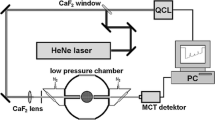Abstract
Molecular-beam mass spectrometry (MBMS) has proven to be a powerful tool for the general analysis of flame structure, providing concentrations of radical and stable species for low-pressure flat flames since the work of Homann and Wagner in the 1960’s. In this paper, we will describe complementary measurements using electron-impact ionization with a high-mass-resolution quadrupole mass spectrometer and vacuum-ultraviolet photoionization in a time-of-flight mass spectrometer. Isomers are resolved that have not been separately detectable before in MBMS studies of flames, including C3H2, C3H4, C4H3, C4H4, C4H5, C6H6, and C2H4O. The qualitative and quantitative results of MBMS have led to advances in modeling and applying flame chemistry.
Similar content being viewed by others
References
J. C. Biordi, C. P. Lazzara, and J. F. Papp, “Molecular beam mass spectrometry applied to determining the kinetics of reactions in flames. I. Empirical characterization of flame perturbation by molecular beam sampling probes,” Combust. Flame, 23, 73 (1974).
I. R. Slagle, J.-Y. Park, M. C. Heaven, and D. Gutman, “Kinetics of polyatomic free radicals produced by laser photolysis. 3. Reaction of vinyl radicals,” J. Amer. Chem. Soc., 106, No. 16, 4356 (1984).
A. McIlroy, T. D. Hain, H. A. Michelsen, and T. A. Cool, “A laser and molecular beam mass spectrometer study of low-pressure dimethyl ether flames,” Proc. Combust. Inst., 1647–1653 (2000).
T. A. Cool, A. McIlroy, P. R. Westmoreland, et al., “A photoionization mass spectrometer for studies of flame chemistry with a synchrotron light source,” Rev. Sci. Instrum., 76, 094102-1–094102-7 (2005).
A. Bhargava and P. R. Westmoreland, “Measured flame structure and kinetics in a fuel-rich ethylene flame,” Combust. Flame, 113, 333–347 (1998).
S. G. Lias, “Ionization energy evaluation,” in: P. J. Linstrom, W. G. Mallard (eds.), Chemistry WebBook, Standard Reference Database Number 69, National Institute of Standards and Technology, Gaithersburg (2005); http://webbook.nist.gov.
T. A. Cool, K. Nakajima, T. A. Mostefaoui, et al., “Selective detection of isomers with photoionization mass spectrometry for studies of hydrocarbon flame chemistry,” J. Chem. Phys., 119, No. 16, 8356–8365 (2003).
C. A. Taatjes, S. J. Klippenstein, N. Hansen, et al., “Synchrotron photoionization measurements of combustion intermediates: photoionization efficiency of C3H2 isomers,” Phys. Chem. Chem. Phys., 7, 806–813 (2005).
Author information
Authors and Affiliations
Additional information
__________
Translated from Fizika Goreniya i Vzryva, Vol. 42, No. 6, pp. 58–63, November–December, 2006.
Rights and permissions
About this article
Cite this article
Westmoreland, P.R., Law, M.E., Cool, T.A. et al. Analysis of flame structure by molecular-beam mass spectrometry using electron-impact and synchrotron-photon ionization. Combust Explos Shock Waves 42, 672–677 (2006). https://doi.org/10.1007/s10573-006-0100-0
Received:
Issue Date:
DOI: https://doi.org/10.1007/s10573-006-0100-0




